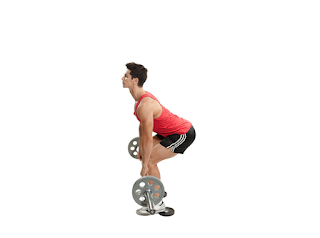Step 1: Keep your feet hip distance apart and lower your body while bending down until your thighs are in parallel to the floor. Keep your back straight and in a neutral, natural position at all times. Hold the bar with an overhand grip with your arms outside the knees. Keep your feet slightly pointed outwards.
Caution: Deadlifts, if performed wrongly,can seriously affect spine and cause lower back pain issues. Follow instructions properly to avoid any mishaps.
Step 2: Keeping your abs and hip muscles tight, push up on the legs to lift the bar. Exhale during the process. Keep the back straight.
Step 3: As the bar reaches your knees, push forward with your hip muscles to straighten your body up and further raise the bar till you are standing tall.
Step 4: Hold this position for 2 seconds. Inhale. Then return to the starting position.



















































